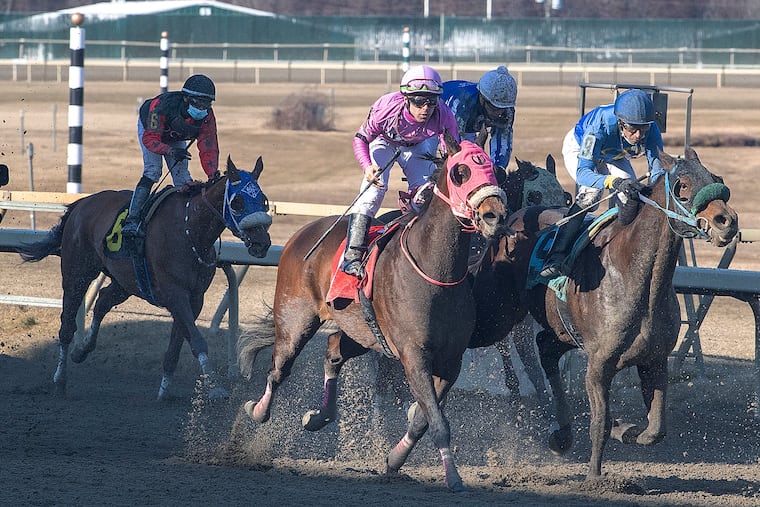Pa. horse racing officials release a new plan for reducing fatalities at tracks
The state agriculture department released data, showing that 85 horses died at Pennsylvania’s three thoroughbred race tacks in 2021, including 56 at Parx Racing in Bensalem.

Pennsylvania Horse Racing Commission officials announced a new plan Tuesday for improving horse safety, as animal fatalities and doping in the industry have generated intense public scrutiny and prompted a federal oversight law.
Among the commission’s proposals are creating a database of fatalities and installing imaging equipment to detect muscle and bone problems, said Tom Chuckas, the state’s director of thoroughbred horse racing.
Separately on Tuesday, the state agriculture department released data to The Inquirer showing that 85 horses died at Pennsylvania’s three thoroughbred race tracks in 2021, including 56 at Parx Racing in Bensalem — approaching the recent high of 59 horse deaths at Parx in 2019.
From 2010 to 2020, more than 1,400 thoroughbreds died in Pennsylvania, The Inquirer reported last year.
Racing directly supports more than 7,000 jobs in Pennsylvania, according to one 2018 analysis. The industry is also one of most heavily subsidized in the state, having drawn about $3 billion diverted from slot machine revenue since 2004.
The safety working group included race track executives, thoroughbred horsemen, veterinarians, and four members of the racing commission. All have a role to play in resolving safety issues, Chuckas said.
Chuckas described the list of action items as a “living and breathing list.” There will be changes, he said.
“It’s a start, but it’s an important start,” he said.
Chuckas presented the 10 items at Tuesday’s monthly commission meeting, with an implementation date scheduled for March 1. He did not say how the reforms would be funded.
Pennsylvania Agriculture Secretary Russell Redding praised the work, calling it “really important for public perception and integrity of the sport.”
Under the plan, veterinarians will be required to attest horses are “in sound condition and suitable to race.” Veterinarians will also have to examine within 48 hours a horse placed on the vet’s list because of lameness. And there will be “stricter criteria” to remove a horse from the vet’s list.
Trainers will have to submit a “pre-entry” form to a panel for permission to race, Chuckas said, which will include a horse’s most recent 30-day medical report.
As for giving a horse “intra-articular injections” — typically shots used to treat pain — an initial round would be allowed by a vet’s recommendation, but “any additional injections require diagnostics,” Chuckas said.
The plan calls for the installation of imaging equipment, to be able to conduct PET scans or MRIs, to detect muscle and bone issues in horses, Chuckas said.
A database of fatalities will also be created under the plan, he said.
“I think we’re staying in line with what needs to be done to protect our horses,” Salvatore DeBunda, a horse racing commissioner who took part in the working group, said during Tuesday’s meeting. DeBunda is also president of the Pennsylvania Thoroughbred Horsemen’s Association (PTHA), the group of owners and trainers of horses that race at Parx.
Representatives for Parx Racing and the PTHA did not immediately respond to requests for comment about the safety recommendations or the 2021 fatality data on Tuesday.
Bryan Langlois, a small-animal veterinarian and advocate for horse safety, commended the plan as an “amazing start” during the public comment portion of the commission meeting.
It will “go a long way” toward improving horse welfare, as well as public perception, he said.
Langlois also urged the commission to consider penalties severe enough “to act as a deterrent” if rules are violated.
“That seems to be one of the biggest drawbacks to regulations and rules that are throughout the country in racing,” he said. Penalties are “basically just slaps on the wrist.”
George Strawbridge, a Chester County horseman and safety advocate, said the new safety points “sound like very wise steps to me.”
“These animals are so very vulnerable with a very big body on very thin legs,” he said. Across the industry, he said, “the amount of breakdowns is significant, and any steps that can be taken to improve the criteria for getting into a race — as far as soundness is concerned — is a really helpful and wise step.”
The doping or horses remains the industry’s biggest problem, Strawbridge said, but cheaters often come up with a “new source of stimulation that is not detectable.”
“Good for the Pennsylvania racing commission taking steps to address this issue,” he said.